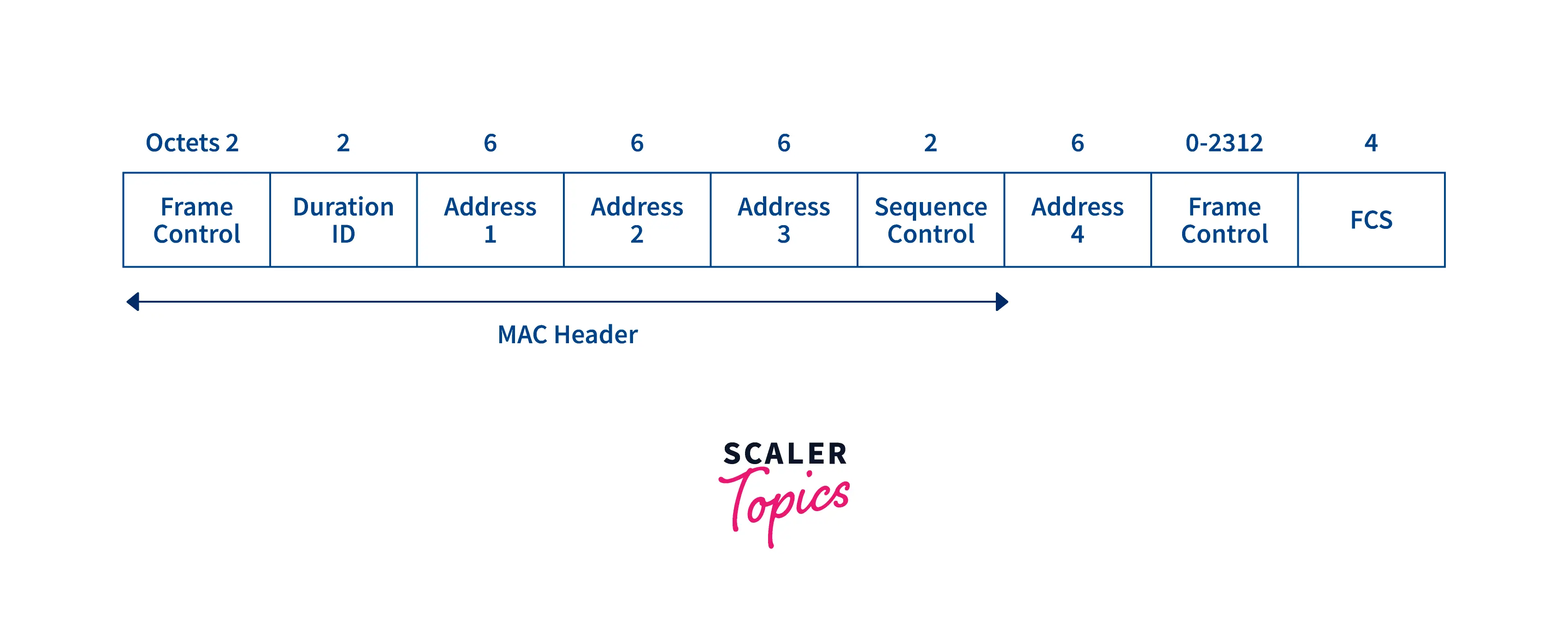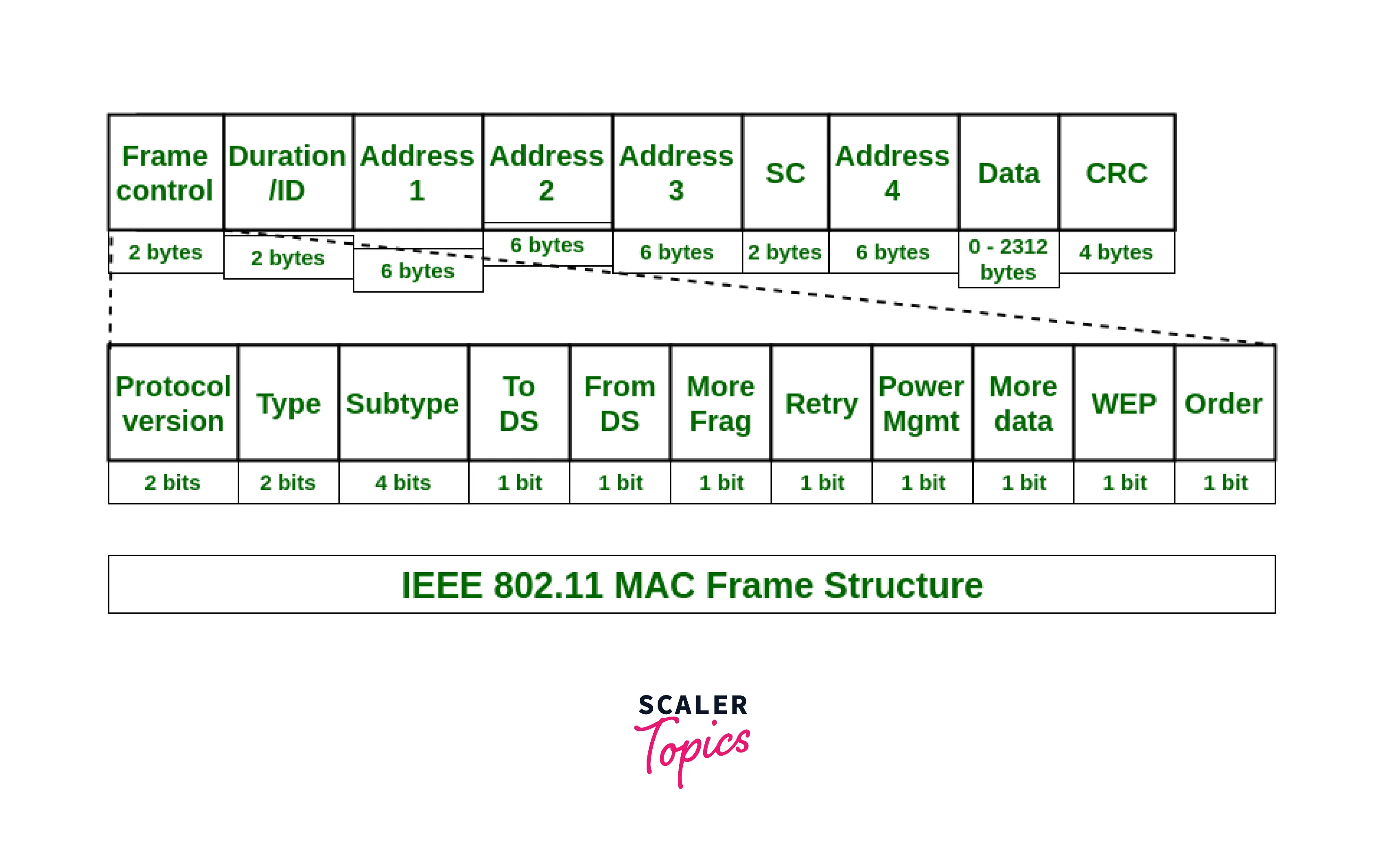The IEEE 802.11 standard specifies the structure and specifications for wireless local area networks (WLANs). For LAN device connectivity, WLAN or WiFi uses high-frequency radio waves rather than cables. Within the network coverage region, users connected via WLANs can roam about. The MAC layer provides the capability for various tasks, such as controlling medium access, and can also provide roaming, authentication, and power conservation. The essential services offered by MAC are the mandatory asynchronous data service and the optional time-bounded service.
Introduction to IEEE 802.11 MAC Frame
What is IEEE 802.11
- It is a set of standards for deploying Wireless Local Area Networks (WLAN).
- It is created and maintained by the IEEE (Institute of Electrical and Electronics Engineers) LAN/MAN Standards Committee (IEEE 802).
- It operates in the 2,4,3.6, and 5GHz frequency bands.
- There are several variations of 802.11, including 802.11a, 802.11b, and 802.11g.
The 802.11 MAC sublayer abstracts the physical layer from the logical link control sublayer and upper layers of the OSI network. It is in charge of encapsulating frames as well as describing frame formats. The MAC layer provides the capability for various tasks, such as controlling medium access, and can also provide roaming, authentication, and power conservation. The essential services offered by MAC are the mandatory asynchronous data service and the optional time-bounded service.
The 802.11 MAC Frame comprises three components the header, the body, and the FCS.
- MAC header:- It is comprised of the following fields: frame control field, duration, address fields 1-3, and sequence control field.
- Frame body:- This field varies in size and contains information based on the type of frame to be carried.
- Frame Check Sequence (FCS):- This is a 32-bit CRC (i.e., cyclic redundancy code).

IEEE 802.11 MAC Frame Format
The following diagram shows the key fields of a frame in WLANs according to IEEE 802.11 standards.

- Frame Control(FC):- This field, which describes the type of frame and some control information, is 2 bytes long. Control information contains whether the frame is to or from a DS (Distribution System), fragmentation information, and privacy information. There are 11 sub-fields present in this field.
- Version:- It is a two-bit field that shows the current protocol version, which is currently set to 0.
- Type:- It is a two-bit field that specifies whether the frame is a control frame (01), a data frame (10), or a management frame (00). The value 11 is reserved.
- Subtype:- It is a four-bit subfield that indicates whether the control frame is a Request to Send (RTS) or a Clear to Send (CTS). The value for a regular data frame is 0000.
- To DS:- It is a one-bit field that, when set, indicates that the destination frame is for DS (distribution system).
- From DS:- A one-bit subfield indicates if the frame is from the DC (distribution system).
- More fragments:- It is a single-bit subfield that, when set to 1, indicates that further fragments will follow.
- Retry:- It is a single-bit field set to 1 if the current frame is a retransmission of an earlier frame.
- Power management:- It is a one-bit field that shows the mode of a station after successful frame transmission. If this subfield is set to 1, it indicates that the sender is in power-saving mode, and set to 0 indicates that the station stays active.
- More data:- It is a single-bit subfield indicates that the sender has additional data frames for the receiver.
- WEP (Protected Frame):- It is a one-bit field that indicates that the standard 802.11 security mechanism is being utilized.
- Order:- The final one-bit subfield instructs the receiver that the frames should be in an ordered sequence to the higher levels.
- Duration/ID:- It is a four-byte field that includes the value representing the amount of time the medium is occupied (in micro(µ) seconds).
- Address fields:- There are three six-byte address fields, one for the source, one for the immediate destination, and one for the final endpoint.
- Sequence Control (SC):- It’s a two-byte field that holds the frame numbers. It detects duplicate frames and determines the sequence of frames for higher layers. The first four bits of the sixteen bits identify the fragment, while the remaining twelve bits contain the sequence number, which increases with each transmission.
- Data:- It is a variable length field that contains information specific to particular frames and is sent transparently from sender to receiver(s).
- CRC (Cyclic redundancy check):- It is a 4-byte field that carries a 32-bit CRC error detection sequence to ensure that the frame is error-free.
Additional Resources
Kindly refer to these various relevant articles from scaler topics to enhance and consolidate your learning.
- How Does WiFi Work?
- What is MAC Address?
- MAC Filtering in Computer Network
- IEEE Standards in Computer Networks
- History of Computer Network
Conclusion
- The IEEE 802.11 standard specifies the structure and specifications for wireless local area networks (WLANs).
- WLAN or WiFi uses high-frequency radio waves rather than cables for tranferring data between two devices.
- The MAC layer provides the capability for various tasks, such as controlling medium access, and can also provide roaming, authentication, and power conservation.
- The 802.11 MAC sublayer abstracts the physical layer from the logical link control sublayer and upper layers of the OSI network.
- The following are the key fields of a frame in WLANs according to IEEE 802.11 standards.
- Frame Control(FC)
- Duration/ID
- Address fields
- Sequence Control (SC)
- Data
- CRC (Cyclic redundancy check)
